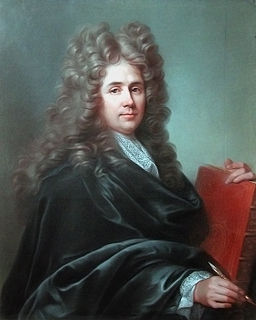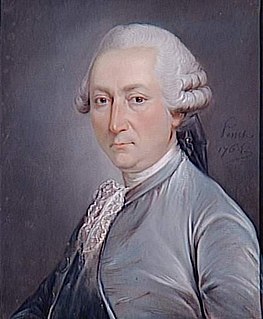
Jean Hupeau (1710 - Paris, 10 March 1763 [1] ) was a French architect and engineer best known for building the George V Bridge in Orleans.

Jean Hupeau (1710 - Paris, 10 March 1763 [1] ) was a French architect and engineer best known for building the George V Bridge in Orleans.
In 1731 he was appointed engineer of the généralité of Riom and then of that of Soissons. On May 8, 1742, he was appointed inspector of bridges and roads, and in 1754, first engineer to replace Germain Boffrand. [1]
His art was recognized and on January 10, 1757, he was elected to the Académie royale d'architecture. [2] He died on March 10, 1763, after a long illness [3] and was replaced by Jean-Rodolphe Perronet as a case of the Corps des Ponts et Chaussées. [1]
In 1750, he drew up the project for the Orléans Bridge. The bridge was not built in the Rue de Recouvrance, but upstream 49 meters allowing to trace, in perfect alignment, the Rue Royale with Avenue Dauphine. The traffic design is harmonious and you can see the work of an urban planner. [4]
For this project he succeeded Robert Pitrou, also an inspector general, who had already designed the same bridge. He questioned the previous project and proposed a more economical design: a bridge with 9 arches instead of 11 and a length of 165 meters instead of 189. [4]
He was an architect who perfectly adapted the work to its destination and site. He had a sense of visual pleasure, a pleasure born largely of habit that led him to harmoniously combine the best projects he had already seen. For the ramps he chose the minimum value, as Louis de Règemorte had done at Moulins. The final result is of great nobility and simplicity, which led him to remove, during the execution of the works, the obelisk foreseen in the project. The pavilions and facades of the Rue Royale, also by his hand, are in the same classical style. [4]
A few years later he directed the construction of the bridges of Joigny and Cravant on the Yonne River and those of Montereau and Mantes on the Seine. [1]
Finally, he designed the Trilport bridge over the Marne, a project of a bridge with three low arches with spans of 26 meters, and whose piers formed an angle of 72 degrees with the axis of the bridge. Hupeau's design was adopted in preference to a design by Perronet, and the work was directed by Chézy. [1]
Since the delivery of the George V bridge in Orleans was to be made one year after the start of the work, the difficulties encountered lead to a postponement of this deadline by two years. Thus the builder Jean Hupeau, who died on March 10, 1763, in Paris, left the completion of his main work to his successor.

École des Ponts ParisTech is a university-level institution of higher education and research in the field of science, engineering and technology. Founded in 1747 by Daniel-Charles Trudaine, it is one of the oldest and one of the most prestigious French Grandes Écoles.

Benoît Paul Émile Clapeyron was a French engineer and physicist, one of the founders of thermodynamics.

Claude-Louis Navier, was a French mechanical engineer, affiliated with the French government, and a physicist who specialized in continuum mechanics.

Robert de Cotte was a French architect-administrator, under whose design control of the royal buildings of France from 1699, the earliest notes presaging the Rococo style were introduced. First a pupil of Jules Hardouin-Mansart, he later became his brother-in-law and his collaborator. After Hardouin-Mansart's death, de Cotte completed his unfinished projects, notably the royal chapel at Versailles and the Grand Trianon.

The Académie Royale d'Architecture was a French learned society founded in 1671. It had a leading role in influencing architectural theory and education, not only in France, but throughout Europe and the Americas from the late 17th century to the mid-20th.

Germain Boffrand was a French architect. A pupil of Jules Hardouin-Mansart, Germain Boffrand was one of the main creators of the precursor to Rococo called the style Régence, and in his interiors, of the Rococo itself. In his exteriors he held to a monumental Late Baroque classicism with some innovations in spatial planning that were exceptional in France His major commissions, culminating in his interiors at the Hôtel de Soubise, were memorialised in his treatise Livre d'architecture, published in 1745, which served to disseminate the French Louis XV style throughout Europe.

Jean-Rodolphe Perronet was a French architect and structural engineer, known for his many stone arch bridges. His best known work is the Pont de la Concorde (1787).

Daniel-Charles Trudaine was a French administrator and civil engineer. Trudaine was one of the primary developers of the present French road system.

Louis-Alexandre de Cessart was a French road and bridge engineer.
Jean Aubert was a French engineer. In 1961 he used the idea of the German engineer Julius Greve from the last century to describe a pente d'eau, which was a way of moving boats up the gradient of a canal without locks. The design consisted of a sloping channel through which a wedge of water on which the boat was floating could be pushed up an incline. This concept was used in both the Montech water slope and the Fonserannes water slopes.

The Place Dauphine is a public square located near the western end of the Île de la Cité in the first arrondissement of Paris. It was initiated by Henry IV in 1607, the second of his projects for public squares in Paris, the first being the Place Royale. He named it for his son, the Dauphin of France and future Louis XIII, who had been born in 1601. From the "square", actually triangular in shape, one can access the middle of the Pont Neuf, a bridge which connects the left and right banks of the Seine by passing over the Île de la Cité. A street called, since 1948, Rue Henri-Robert, forty metres long, connects the Place Dauphine and the bridge. Where they meet, there are two other named places, the Place du Pont-Neuf and the Square du Vert-Galant.
Antoine Picon is a 20th-/21st-century French professor of the History of Architecture and technology and co-director of Doctoral Programs at the Harvard Graduate School of Design. He teaches courses in the history and theory of architecture and technology. He is member of the scientific committee of the École Nationale Supérieure d'Architecture de Versailles -ENSAV-

Jean Beausire was an architect, engineer and fountain-maker and the chief of public works in Paris for King Louis XIV of France and King Louis XV of France between 1684 and 1740, and was the architect of all the public fountains constructed in Paris that period. Several of his fountains still exist and continue to work. Three streets in the 4th arrondissement of Paris today carry his name: Rue Jean-Beausire, Impasse Jean-Beausire, and Passage Jean-Beausire.

Paul Séjourné was a French engineer who specialized in the construction of large bridges from masonry, a domain in which he made some important innovations.
Jacques-Guillaume Legrand was a French architect and critic.
Thomas Dumorey was a French civil engineer and architect. He was the chief ingénieur des ponts et chaussées for the States of Burgundy.
Émiland Marie Gauthey was a French mathematician, civil engineer and architect. As an engineer for the Estates of Burgundy, he was the creator of a great deal of the region's civil infrastructure, such as the Canal du Centre between Digoin and Chalon-sur-Saône (1784–1793), bridges including those at Navilly (1782–1790) and Gueugnon (1784–1787), and buildings such as the Eglise Saint-Pierre-et-Saint-Paul at Givry and the theatre at Chalon-sur-Saône.
Thomas Gobert was a 17th-century French architect and engineer.
Nicolas Delespine was a French master mason, entrepreneur and architect. He belonged to a dynasty of Parisian master masons.
Jean-Charles-Alexandre Moreau (1762–1810) was a French history painter, decorative painter and architect. He was born in Rimaucourt near Neufchâteau, Vosges. He studied architecture in Paris with Louis-François Trouard and won the first prize in architecture in the Prix de Rome competition of 1785. He visited Rome four times during his career. Later he studied history painting with Jacques-Louis David. From 1797 to 1810, he exhibited at the Paris Salon. In 1798 he renovated the theatre of the Comédie-Française. According to his entry in the Benezit Dictionary of Artists, Moreau died in 1810 in Paris. However, the German Wikipedia cites a study published in 2014, which shows he is identical to a French architect, who in 1803 moved to Austria, where he was known as Karl Moreau, had a very productive career, and died in 1840.